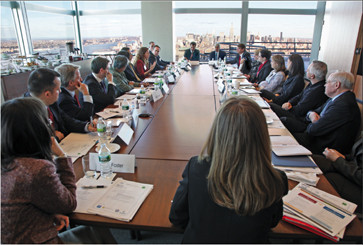 Roundtable participants. (Photos by Joe Vericker, Photobureau Inc.)
Roundtable participants. (Photos by Joe Vericker, Photobureau Inc.)
Watch the Shared Value Roundtable video.
A growing number of multinational corporations—including Unilever, Intel, and Wal-Mart Stores—are embracing a new way of doing business, one that puts societal issues at the core of the company’s strategy and operations. This approach differs from traditional “corporate social responsibility,” which is often built around compliance with environmental and social regulations, improving the corporation’s reputation, and unfocused charitable giving to a variety of causes frequently unrelated to the business.
The new approach to doing business, dubbed “creating shared value” by FSG co-founders Mark Kramer and Michael Porter, extends well beyond those practices. (See their cover story, “Creating Shared Value,” in the January-February 2011 issue of the Harvard Business Review.) Shared value is created when companies generate economic value for themselves in a way that simultaneously produces value for society by addressing social and environmental challenges. Companies can create shared value in three distinct ways: by reconceiving products and markets, redefining productivity in the value chain, and building supportive industry clusters at the company’s locations.
Shared value taps the capacity of global businesses to solve social problems, just as social entrepreneurs do through smaller-scale enterprises. Porter and Kramer believe that widespread adoption of a shared value approach could reshape capitalism and its relationship to society. They also predict that it will drive the next wave of innovation and productivity growth in the global economy as it opens managers’ eyes to immense human needs that must be met, large new markets to be served, and the internal costs of social deficits—as well as the competitive advantages available from addressing them.
The idea that companies should create shared value carries many implications that corporate leaders are only beginning to understand, which is why we brought together corporate practitioners to share their experiences and discuss evolving practices. On Dec. 8, 2010, executives from 10 major corporations gathered at Goldman Sachs’s New York City headquarters to discuss how their companies were implementing shared value. They were brought together by FSG, the Stanford Social Innovation Review, and the Committee Encouraging Corporate Philanthropy (CECP). Some of the companies—such as Cisco Systems, Hewlett-Packard, and IBM—have been taking a shared value approach for some time. Other companies—such as Western Union, Alcoa, and InterContinental Hotels Group—are new to the approach. But all of the participants—which also included Goldman Sachs, Dow Chemical, Medtronic, and PG&E—are enthusiastic about the results and prospects for the future.
The candid discussion, led by Kramer and FSG managing director John Kania, was wide ranging and posited a number of interesting shifts in the way companies address social problems when they pursue shared value. It profoundly changes the relationship between companies and nonprofit organizations, creating a mutual interdependence and heightened accountability for delivering results. Shared value engages companies more deeply in social issues, holding the promise of far greater resources and a multitude of innovations to address today’s most urgent needs. Above all, it accelerates and expands the potential for social impact as major corporations launch initiatives that reach millions of people at a pace and scale that have rarely been achieved by the nonprofit sector. At the same time, as the participating executives acknowledge, shared value demands a delicate balance between social needs and corporate profitability that is not easily achieved.
ROUNDTABLE PARTICIPANTS:
Talya Bosch, director of corporate social responsibility, Western Union
Roslyn Dickerson, senior vice president of corporate responsibility and public affairs, InterContinental Hotels Group (IHG)
Paul Ellingstad, director of the office of global social innovation, Hewlett-Packard
David Etzwiler, executive director of Medtronic Foundation, and vice president of community affairs, Medtronic (has since left Medtronic)
Reginald Foster, regional manager of corporate citizenship and corporate affairs, IBM
Ezra Garrett, executive director of PG&E Corporation Foundation, and director of community relations, PG&E
John Kania, managing director, FSG
Tony Kingsbury, senior leader, Dow Chemical, and Dow Executive in Residence, Sustainable Products and Solutions Program at the Haas School of Business, University of California, Berkeley
Mark Kramer, co-founder and managing director, FSG
Noa Meyer, vice president, Goldman Sachs
Kathy Mulvany, senior director of corporate affairs, Cisco Systems
Dina Habib Powell, president of Goldman Sachs Foundation, and global head of the office of corporate engagement, Goldman Sachs
Beth Schmitt, director of recycling for Alcoa North American Rolled Products, Alcoa
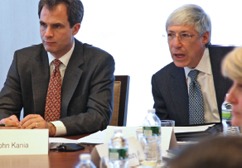
Mark Kramer: Let’s start with the question of motivation. When did your company begin to adopt the perspective of shared value, and what prompted that change?
Ezra Garrett: At PG&E, a paradigm shift occurred in the aftermath of the mid-2000s energy crisis. Our CEO, Peter Darbee, made a bold public statement: that we believe climate change is real, and that as a member of the utility industry we have to take the leadership role in finding solutions to that problem. So we articulated a vision of being the leading utility company in the United States, and to support that we outlined four simple goals, to be a leader in engaged employees, delighted customers, environmental leadership, and total shareholder return. That reflects the triple bottom line concept of shared value.
We then said, “Why don’t we propose a really aggressive program to help incentivize our customers to use less energy?” Colleagues in the industry—and I don’t mean just the utility industry, but big businesses—asked us: “What in the heck are you thinking? How can you encourage your customers to use less of your product?” But we knew it was the right thing to do and we knew that we could work within that framework to provide offsets to the customers to take those steps.
Where the value creation really happened was when we were able to bake these incentive programs into our corporate strategy. Instead of it being just a PR thing, we really put skin in the game, to make sure that customers actually did reduce their usage. We’re committed to paying a pretty hefty fine if customers don’t meet those goals. And it has worked. Over the past 30 years energy usage in the United States has gone up 50 percent per capita, whereas in our service area it’s remained steady.
The challenge on the philanthropy side of the company was, how do we create a new charitable program that is reflective of our environmental leadership goal? So, for example, we created a program with Habitat for Humanity where we fund the installation of solar on every Habitat home built within our footprint in Northern and Central California. Major change is a challenge for any organization, and for a 100-year-old utility company like us, it really took something as drastic as the energy crisis to get us to initiate that change and see it through.
David Etzwiler: For Medtronic, the shift began when we moved into emerging markets. It became clear to us that the old innovation model that we had used in the United States and other developed countries is not effective when you try to develop and sell products for the middle and the bottom of the economic pyramid. Instead, we had to go into a community and start from scratch by asking the question, “What’s not happening here that could happen, and how do we address it?”
Sometimes the answers to that question are coming from those of us who spend time with NGOs. Other times it’s coming from our government affairs folks. And other times it’s coming from our business model innovation folks. As a result, there was a slowly developing Aha! moment—that we’re really learning innovation through shared value. Our CEO absolutely drank the Kool-Aid with us. He assigned a top-level executive committee to oversee this work. And we engaged in a process that led us to underscore the vision of working to serve folks in the middle and bottom of the economic pyramid.
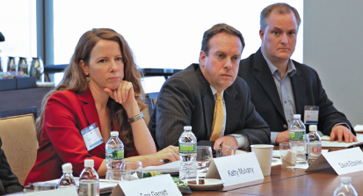
Kathy Mulvany: At Cisco it really began with our employees. In the early days of Cisco we were based in East Palo Alto [California], which is not the safest neighborhood in the world. Some of our employees wanted to get engaged in the community. We happened to be next to a school, and we thought, “We’re a technology company, let’s go in and wire the school for Internet access.” But as often happens, we realized that it’s one thing to give technology. It’s another thing for that technology to actually have some benefit if nobody knows how to use or maintain it.
Out of that realization, an employee said, “Why don’t we teach the students how to use the technology?” John Morgridge, who was our CEO and chairman at the time, liked the idea, and it led to the creation of the Cisco Networking Academy. It was driven both bottom-up and top-down. You have to have executive leadership that absolutely believes in it and is passionate about it, as John was then, and John Chambers, our current CEO and chairman, is today. He absolutely believes it is relevant to the business. He continually says that social investment and giving back to communities is the right thing to do, and it’s also very good for business.
Roslyn Dickerson: The beginning for IHG was new leadership at the company and a shift in our strategy. Heretofore, we approached the business as an operating company. Heads in beds. We didn’t much care about their experience. We just wanted them in our hotel.
Our new CEO came from Cadbury Schweppes, a consumer brand company, and he began our transition to a brand-led company. Now it isn’t just about the head in the bed. It is the guest’s experience that matters. Our mission as a company today is to create great hotels guests love.
In our research we found that there are a few things that factor into the customer’s experience. First, we discovered that the customers’ love of the experience is directly correlated with the service they receive. If the person working at the hotel is happy, I [the customer] know I’m going to get better service. If they’re better trained, I’m going to get better service. If they’re using healthier products, I know I’m going to get better service.
Another factor that arose in our research about the customer’s experience was the notion of safe hotels. We expected customers to bring up the importance of having a safe hotel. What we didn’t expect was that a safe hotel was associated with having a safe environment and a safe planet. And last, we began to consider a very interesting philosophical question that our board of directors raised after looking at all of the data. And that question was, what’s the role of a hotel in society today? That took us down a path of understanding what the hotel represents to a community. Hotels are a very intimate thing. If you live in a small town, you know. They are the place where you have bar mitzvahs and weddings and some of the best experiences in your life. And it’s also where you go for shelter in times of need. We learned that we already had a connection to the community that we just weren’t leveraging.
Those were the catalysts for us. We’ve got a lot of data and good anecdotal information. Now we’re pulling it together to represent both the environmental sustainability component of this work and the community component of this work.
Reginald Foster: IBM has a long commitment to contributing to society, but recently we found that more and more of our customers were talking and thinking about these things. We did global CEO studies, which found that CEOs as a group were ahead of the public in being concerned about sustainability, climate change, and these kinds of issues. They were worried about the impact on them, on their kids, and so on. So one of our new programs is something called the Smarter Cities Challenge, which will award $50 million in grants over three years to 100 cities around the world to help them solve health, traffic, safety, grid, water, these kinds of problems that are all related to growth and sustainability.
Paul Ellingstad: In the last 10 years
Hewlett-Packard has gone though an interesting time. Under our former CEO, Carly Fiorina, we were really engaged in social innovation. It was like clockwork. She would
be in Davos one week and in South Africa
the next week. We did some fascinating
things around digital inclusion in South
Africa in particular. Unfortunately, at that time the company’s financial and operational performance did not consistently match
the amazing things that were being done in
terms of social impact.
The pendulum then swung under CEO Mark Hurd; the next five years were very focused on financial and operational performance and social impact reverted to a more traditional corporate philanthropy model. Since late 2009 we’ve undergone a transformation, moving from the philanthropy model to begin really looking at how we leverage the 300,000 employees and all the expertise we have in solving social problems.
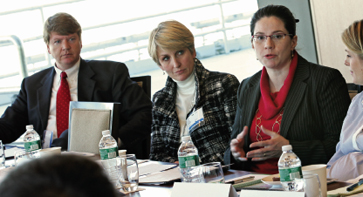
Kramer: It’s clear that the reason a company embarks on a shared value strategy can vary widely. The shift can be driven by customers, employees, CEOs, markets, and external events. Before we dive into some other questions, I’d like to hear from the rest of you about your shared value programs. Noa, what is Goldman Sachs doing?
Noa Meyer: The Goldman Sachs Foundation is focused on economic growth and opportunity, which is aligned closely with the work of Goldman Sachs the company. We launched 10,000 Women about three years ago, based on research that looked at how increasing the participation of women in the labor force increases GDP. Today, more than 3,000 women in 22 countries have graduated from the program. A little over a year ago we launched 10,000 Small Businesses in the United States. We started in New York and are also in Los Angeles and New Orleans.
Goldman Sachs employees are clamoring to assist those two programs by serving as mentors and providing feedback on business plans. There’s just an enormous amount of interest and desire by our employees to be involved. Our work is obviously serving the communities in which we live and work, but it is also providing the roughly 30,000 people who work for Goldman Sachs opportunities to use their skills in ways that are meaningful for them.
Talya Bosch: Like many other companies here, Western Union is an old one—about 160 years old. We probably started with the idea of shared value as soon as we started moving money, although we certainly wouldn’t have known to call it that at the time. We obviously are proud of our philanthropy and the Our World, Our Family program. We also consider corporate citizenship as giving back to create economic opportunity.
What’s emerging for us is a much more intensive and purposeful focus on the shared value piece. A lot of the money that moves through Western Union is repatriations—sending money home. It’s up to half the GDP in some developing nations. It is double all sources of international aid combined.
What I get to wrestle with every day is how you translate Western Union’s scale into shared value. We care a lot about the underserved, traditionally migrants and the bottom of the pyramid. We also find that small businesses are not necessarily well served. But it actually isn’t as easy as you would think to come up with a practical answer to the question “What do we do to serve the world profitably?”
Beth Schmitt: I’m probably the only person at the table who’s not part of a corporate affairs organization or a foundation. I’m embedded within Alcoa’s North American world products business. That says something about how Alcoa has integrated sustainability as a core business strategy throughout the organization.
Alcoa is an integrated aluminum company, from mining to recycling. I’m responsible for delivering shared value by helping to drive the recycling rate up for all of the rolled products that we sell. Energy savings, greenhouse gas emission savings, all benefit the communities in which we operate. I work with NGOs, government organizations, and other interested parties to increase diversion rates and bring those natural resources back into our operations. It’s a three-pronged approach, developing products that serve customers, serve markets, and serve communities.
Tony Kingsbury: I pulled together a list of 36 new products, which are what I call candidates for breakthroughs to world challenges. Here’s one example. We all hear about the bad oils that are clogging up our arteries and leading to heart disease or diabetes. Dow has innovated healthy high Omega-9 and soon Omega-3 oils. These are canola-based oils, so there’s virtually no difference in how they are grown, and there’s no difference in how they taste. The neat thing about this innovation is that it’s a win, win, win. These healthy oil products are becoming popular in the United States, Canada, Japan, and Europe. We hope soon, throughout the world.
Another example is solar shingles. This is an asphalt shingle but with photovoltaics built into it. We came up with the idea after going out to our customers in the building and construction industry, who told us that the installation cost for photovoltaics can be as much as or more than the actual product. With solar shingles, you can provide photovoltaics much more cost-effectively by dropping installation costs and integrating it into the roof without the need for special construction techniques. We’re just coming out with those, and there’s far more demand for them than we can supply. Now we just have to figure out how to ramp up quickly.
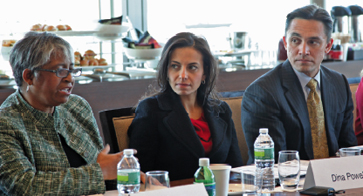
Kramer: Ideally, companies create solutions like those that Dow has, ones that benefit the company, society, and the environment. But that isn’t always the case. As philanthropic programs get integrated more tightly into a firm’s core business it can create problems. Reg, is Smarter Cities purely a philanthropic program? And how do you avoid the appearance or reality of self-dealing, in which your grants might seem to benefit IBM’s consulting business?
Foster: To clarify the terminology, IBM has talked about smarter planet and smarter cities in our business approach and the need to find new solutions to public safety, health, education, electric grid, and other system issues confronting us, especially in cities—where more than half of humanity now live. Smarter Cities Challenge is our competitive philanthropic grant program that allows cities to apply for grants of IBM consulting help to tackle these critical problems. We are bringing the best of our expertise and talent to our philanthropy to help solve problems, which we think is critical to being effective. Similarities will always exist between grants and business when companies give of their expertise, but we will administer the grants with transparency and integrity, and that is what is required to achieve real change.
Bosch: The separation of church and state raises some interesting challenges for us at Western Union. We have given grants to organizations in Uganda to work on how financial literacy information can be distributed via mobile phone. Now, very rapidly, Uganda could become a business opportunity for us. How do we work with our marketing teams, how do we work with our business team, and how do we develop new products for that market while making sure that our philanthropy is effective? We had a great opportunity to work with Mercy Corps, our close partner in Haiti, to fund some of their mobile phone work. We decided not to, because we knew that mobile money would soon be a business play for us.
To give you yet another example, we recently bought a company called Custom House Solutions, which is now Western Union Business Solutions. In the United Kingdom, one of their largest markets is the nonprofit sector. That presents a shared value opportunity as well as a number of challenges. How do we work with nonprofits in our grantmaking who could also become our clients in another arm of the company? How could we use Custom House Solutions to generate shared value? These are tricky issues.
Mulvany: Cisco’s social investment goals are aligned to our business, but when it comes to the Cisco Foundation there can be no direct business benefit to the corporation, so you have to be very aware of the rules of engagement. For example, as we move into health care from a social benefit perspective, we are not going to be funding those engagements through the Cisco Foundation but rather through the corporation.
Kramer: That raises an interesting point. What impact has shared value had on your company’s grantmaking and its decisions about which NGOs to partner with?
Foster: First of all, it dramatically narrows whom you might work with and what you might decide to do with them. It’s narrower but it’s deeper. I don’t want to go quite this far, but we almost wouldn’t do a grant now unless there is value and contribution on both sides. Because not only do we have something specific that we want to accomplish, but we are engaged in a way that we have a window on the results that we would never have had if we had simply written a check. So it’s a much different relationship but a stronger one.
Dickerson: We were engaged with lots of partners, many focused on education, which is so broad I don’t know how you win in that space. And as a hotel company we didn’t feel it was relevant enough to our business—we couldn’t win in that space. Today, we don’t have education as a focus. We have hospitality training as a focus, which is a very specific thing. I’ve been pleasantly surprised at how well nonprofits understand the reasons for the change. One of the things that I’ve also found about having that kind of focus is that it allows you to say “No” respectfully, which is quite important to developing and maintaining relationships.
Dina Powell: That’s true. And to Reg’s point, yes, you are entering into deeper relationships with NGOs. Our partnerships with NGOs and academic institutions are anchored in our shared commitment to achieving measurable results. We work closely with our implementing partners to clearly define what success looks like and then tailor each program and grant to maximize our partners’ ability to reach those goals.
Ellingstad: We’ve found some very good social entrepreneurs, such as Bright Simons, from Ghana, who founded a company called mPedigree that allows people to use their mobile phone to verify whether a medication they purchase is authentic or counterfeit. We developed the technology solution and partnered with mPedigree to bring it to the market. But one of the problems we’ve had is trying to sort through the large number of social entrepreneurs there are around the world and identify the ones we want to work with. One of the things we’ve done to help us filter them and make the process more efficient is to partner with the Schwab Foundation for Social Entrepreneurship, which helps us identify high-potential social entrepreneurs.
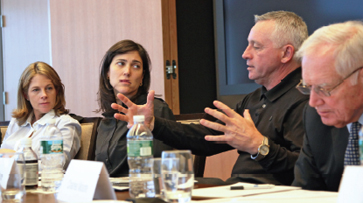
Kramer: One of the things that’s so exciting about shared value is the scale on which you all are talking about your projects. Cisco has nearly 4 million graduates of its Networking Academy, Goldman is empowering 10,000 Women, Dow’s solar shingles are flying off the shelves. These are large-scale impacts that nonprofits don’t often reach.
Kingsbury: NGOs are a critical piece in
identifying the opportunities, but are not
usually able to scale to the appropriate size.
The corporate entities can come in and
take these things to scale. Most NGOs are
not set up to affect a million lives. If you
combine NGOs’ local knowledge with our
ability to scale up, you can really create value on both sides.
By the same token, we have to listen to NGOs so that we don’t go to the wrong place or do the wrong thing. Sometimes we come with our preconceived notion of what the solution should look like. Sometimes it’s “Hi, I’m from Midland [Mich., Dow headquarters) and I’m here to help.” Or “Here’s the way we’re going to do it.” We need to listen to them, but then we need to provide the scaling opportunities.
Garrett: We are the second largest landowner in California, so our reach spans a very diverse geography and set of demographics across the state. We are also the sole gas and utility provider for most of the 15 million people living within this footprint, so people have very high expectations of us. If we’re not conducting our business in a way that is responsible and that acknowledges the impact of our business on their neighborhoods and the environment, then it’s big trouble. Big trouble for us, big trouble for our shareholders, and big trouble for our government regulators as well.
Powell: In this increasingly globalized world there are really three legs of the stool that have to work together—government, private sector, and nongovernmental organizations. For many years it was the government that came up with ideas, and the private sector was asked to fund and scale them. Today, many organizations are showing the government that innovative ideas to combat the world’s most pressing problems can come from a variety of places, and the public and private sectors can work together to bring innovative solutions to scale.
One example is the Overseas Private Investment Corporation (OPIC), an independent US agency, which launched a lending facility for women in Monrovia, Liberia. They announced this commitment at the Clinton Global Initiative. They were so excited about the program, which pledged to award $30 million in growth capital to SMEs [small and medium enterprises] in Liberia. The challenge, however, was that Liberia’s tumultuous history had left the economy fragile and without a large supply of qualified loan recipients. And this was especially true for women who had been out of school for years.
We received a call from the chairman of OPIC saying: “We are searching for loan recipients, but it is clear that many entrepreneurs do not have the training to be successful at growing their businesses. Is there any way you would consider a 10,000 Women program in Monrovia?” That was three years ago. Today, 75 women have participated in 10,000 Women and many of them have access to capital. This partnership is an important example of how public-private models are enabling us to join forces to reach broader populations in larger numbers.
Mulvany: The challenge we’ve faced in scaling the Cisco Networking Academy is how you create a program that is globally consistent yet locally relevant. The power of the program is that every student around the world goes through the same curriculum and is eligible for the same certifications in the end. A student getting a 93 in Kabul, Afghanistan, is just as good as a student getting a 93 in San Jose, Calif. That’s the power of the network and why people are so eager. In addition, we don’t push the academy on anyone. What we have found is that success lies in a pull. When communities and countries see the value of information and communications technology skills education and what it can do for capacity building in their country, they want it and ask for it. The only way that the Cisco Networking Academy has been able to scale to 165 countries and a million students a year is because it is a partnership. The educational institutions we partner with have to create the classroom, hire the teacher, promote the courses, and get the students into the classrooms. We provide them with the curriculum and the instructor training as well as the network foundation for all of the assessments and the learning management system. But it absolutely works only because local entities take ownership.
Bosch: We didn’t have a model where we said, “Here, let’s offer this to the world.” We were co-creating what would work. But solutions to some social problems are more easily scalable than others. The notion of working with government in some way might be a scalable idea, but we’ve been struck by how much some of the things we thought would be scalable, programs that we could package, actually need to be customized.
For example, we have had a program for many years in which migrants in the United States raised money for their local communities in Mexico, and it is matched by us and by the governments of the Mexican states where the communities are located. We thought this was a great model that should be scalable anywhere.
Well, not necessarily, even in Mexico. Not all government entities at the federal, state, and local level have money available at the same time. Even though that program hasn’t worked as a global model, it did help us create a new diaspora business program for Africa and a new partnership with the United Nations Development Programme.
Kramer: Most successful organizations have strong measurement systems. There is also a move afoot to create shared measurement systems across many different nonprofits in the same field. How do you measure success and how important is that to sustaining support for shared value programs within your company?
Powell: We have learned through the last few years at 10,000 Women that holding yourself accountable is critical, but how you actually conduct that measurement and assessment is also important because it has the potential to be something that you can share. Our goal was to reach 10,000 Women. Today, the program operates in 22 countries and 3,500 women have been reached with management education, access to capital, mentoring, and networking.
Goldman Sachs’s culture emphasizes quantifiable results. Even before we launched the program, senior leadership expected a system for measuring the numbers of women reached and the impact of the program. Today, we have a designated measurement and evaluation person at each of our programs. In Rwanda, India, China, and Brazil, part of our grant pays for an M&E liaison who tracks the women from the time they enter the program and at various points after graduation to measure job creation and revenue growth.
Mulvany: If you move to the model of shared value and you want business to be more engaged, the business will absolutely want to see measurement. “Show me that there is real social impact. We are willing to potentially invest more if you can show real value.” But it is a challenge to get consistent metrics. We try to encourage a common set of metrics across our NGO partners and our social programs. It would go a long way if there were one set of standards around what social impact is.
Ellingstad: We’re being very, very careful that we don’t get into a marketing campaign style of measurement and evaluation, where we say, “Look how great we are.” You also need to make sure you are measuring the right things over the right time frames. Some of the very first houses that Habitat for Humanity built fell into disrepair because they hadn’t focused on creating a sustainable model. It’s not just building housing, it’s also how you empower the community so that it takes ownership.
John Kania: We’ve been talking a lot about the current state of shared value programs. Looking forward, how do you think shared value will play out in the future, and how might it change at your company?
Etzwiler: In corporate America you will know shared value has taken root when it’s part of the strategic plan. That’s something we are beginning to do at Medtronic. Moving into emerging markets has caused us to look at health differently. It’s a whole different market when you start looking at models of care that exist and don’t exist, and the expertise that doesn’t exist, and how you can play a role in complementing that with shared value.
Dickerson: As time goes on, eventually it’s not shared value, it’s simply new business development. And there are lots of places inside the organization where new business development occurs. It will allow us to have an even broader scope that takes into consideration what’s going on out there in the community, what’s going on in government, and what’s going on in our own business organization.
By demonstrating the ROI of shared value thinking, we are going to have lots more people inside the organization who want a part of that. We haven’t done that yet. But it’s part of what we want to do, to drive it down to each and every brand. What shared value means to an InterContinental Hotel is going to be very different from what it may mean to a Holiday Inn Express. It will be tons of work, but I can see it being integrated into our company over time.
Kingsbury: Will people say, “Let’s give Tony $100 million for Breakthroughs to World Challenges to go work on something?” The answer is no. Products will be developed only if they make business sense. But if we can develop ways to provide lower-cost clean water so that we can enter new markets, then absolutely money will be available. If we don’t, somebody else is going to do it and capture the value there, so why not us?
Schmitt: You have to be committed to shared value for the long term. It can’t be something that is this year’s campaign, and next year you are on to something else. Aluminum is an energy-intensive industry, and I don’t think the energy issue is going to go away. Being efficient, smart, and innovative in energy usage is not just a competitive advantage, it’s a matter of survival. That’s what makes sustainability a very long-term strategy for us.
Ellingstad: We’re going back to where we were when Bill [Hewlett] and Dave [Packard] founded the company—the ethos that you’re not here just to make money for the company and shareholders. It’s about the organization as well as the employees actively contributing to the communities in which they work and live.
If this is going to be sustainable 100 years from now, it’s got to be part of your corporate values, the fact that your company is a part of a broader ecosystem that contributes to creating societal value. Business must work with governments and with NGOs to build better societies and better communities.
Support SSIR’s coverage of cross-sector solutions to global challenges.
Help us further the reach of innovative ideas. Donate today.
Read more stories by John Kania & Mark Kramer.

